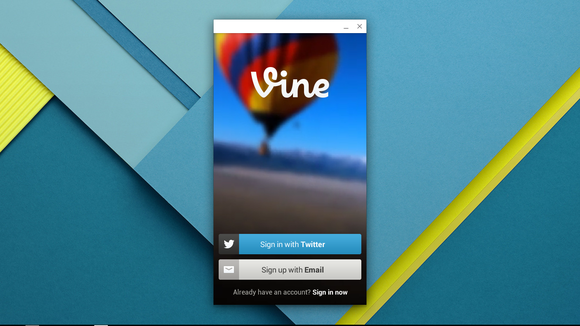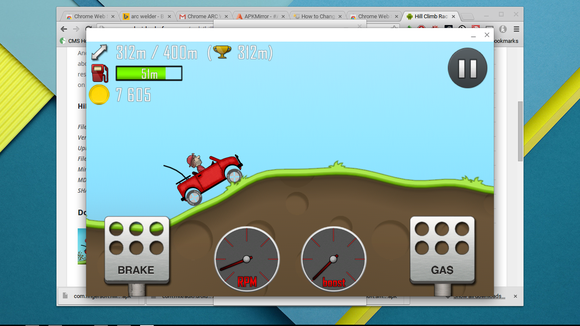I believe you are aware that Google now allows Android apps to run on Chrome, Windows, OS X and even Linux operating system. Well here's how to run those Androids apps in Chrome. You don't have to be a developer to run apps in Chrome or any other operating system..just follow these steps below.
Eventually, Google hopes, you’ll be able to run potentially millions of Android apps within Chrome or Chrome OS once they’re formally ported over. But you can get make that vision start to happen today—with a new Google tool called ARC Welder.
This week, Google began more widely publishing a developer tool called App Run time for Chrome, designed to allow developers to quickly port apps like VLC and others from Android to Google’s Chrome OS. Chrome and Chrome OS have a small number of native apps, but lack the broad app support that Android does.
Then ARC Welder arrived on Thursday—a developer tool in the Chrome store that lets you to try out your own Android apps on Chrome or the Chrome browser. We tried it, and some of those Android apps work pretty well already.
The story behind the story: Let’s make one thing clear: ARC Welder is a developer tool, designed to assist developers to port their Android apps over to Chromebooks and Chrome OS. (Developers can test apps on Chrome running on a PC, Mac, or Linux, but they can't be published to the Chrome Web Store.) Any Android app that you try to port over it will likely be glitchy, and there’s a chance that it won’t work, period. With that said, running Android apps on your Chromebook is fun, just to see what will work and what won’t.
Track down some APKs
For testing, I used the recent Hisense Chromebook released by the Chinese manufacturer this week. I made sure that the Chromebook was upgraded to the latest version of Chrome OS, using the beta, rather than the stable channel. You’ll need to download the ARC Welder app itself from the Chrome store, of course.
What ARC Welder does is is fairly straightforward: The app allows you to launch an Android app (packaged up as an APK file) within Chrome. The app simply intercepts instructions to and from an Android phone or tablet, and routes them through your computer. That means, of course, that apps that depend on location, the back-facing camera, or the orientation of your phone, won’t work. (Fortunately, using the trackpad to simulate swipes and taps seems to satisfy an app that thinks it’s living on a touch-enabled tablet or phone.)
To get an APK file, however, isn’t necessarily that simple. Google doesn’t want Android users to download APK files per se, but use the Google Play store instead. But there are at least a couple of sites that provide you APKs of some of the most popular apps, including AndroidAPKsFree.com and APKmirror.com. You should find it relatively easy to find and download APKs of Snapchat, Kik, or Clash of Clans, for example.
For testing, I tried downloading three Android apps: VLC, Microsoft’s SmartGlass for Android, and Hill Climb Racing, a simple physics-based driving game.
Unfortunately, ARC Welder only supports one app at a time, so don’t expect to run a multitude of Android apps simultaneously, as you might do on your smartphone. When you open the app, it will ask you for the name of the APK you wish to run—and close any other Android apps that it has running. Opening an APK is as easy as clicking on it, however, then selecting what mode to run it in. You can choose to run the app in phone mode, for example—but there’s little incentive too, especially as your PC display is oriented in landscape mode, like a tablet. Your best bet is to tell ARC Welder to open the app in tablet mode, and in landscape; whether you choose to maximize the app to take up your entire screen is up to you.
Glitches ahoy!
I was surprised at how well Android apps translated to my Chromebook screen—and what unexpected glitches resulted. VLC, for example, seemed to run just fine—but the app defaults to an Android file structure, so actually finding a video file on your hard drive proved impossible without knowing the path to the file system. (Unfortunately, I didn't.) And when I tried to select a networked video stream, the app crashed.
I had better luck with the SmartGlass app, which I was able to log into using my Microsoft account. Unfortunately, the version of the app published to the APKMirror site was the Xbox 360-specific version of the app; I own an Xbox One. When I tried to download the One version, the app directed me to Google Play. Stymied!
Finally, I tried Hill Climb Racing, a relatively simple driving game where you’re tasked to accelerate and brake to control a jeep across a series of hills and jumps. And to my surprise, it worked very well. I couldn't connect to the Google billing services to buy virtual currency, but the game otherwise ran smoothly. It's not exactly like an Android tablet, of course; I had to mouse over the icons for gas and break instead of tapping on them.
Please don’t consider ARC Welder to be a one-stop utility for running Android apps on Chromebooks or Windows—it’s simply not. It might not even be at the level of beta software. But as a vision of what Android apps might look like within the Chrome ecosystem, it’s eye-opening.
Credit: http://www.greenbot.com/


